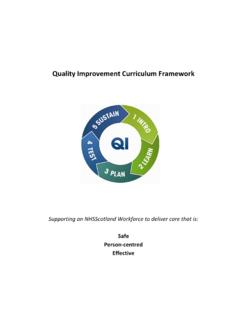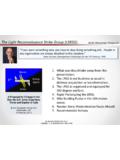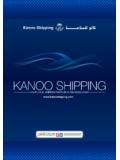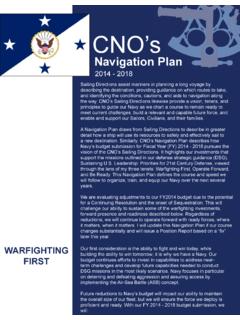Transcription of Strategy - WHO
1 UNDP/World Bank/WHOS pecial Programme for Research andTraining in Tropical Diseases (TDR)Research CapacityStrengtheningResearch CapacityStrengtheningStrategy 2002-2005 Research capacity StrengtheningStrategy (2002-2005)UNDP/World Bank/WHOS pecial Programme for Research andTraining in Tropical Diseases (TDR)TDR/RCS/ document is not a formal publication of the World Health Organization (WHO), and all rightsare reserved by the document may, however, be freely reviewed, abstracted, repro-duced or translated, in part or in whole, but not for sale or for use in conjunction with commercial views expressed in documents by named authors are solely the responsibility of those TDR 2002 Concept and design: Andy Crump and Laura NapolitanoCover and Layout.
2 Lisa SchwarbTDR/RCS/ 5 RCSS trategy(2002-2005)6 Research capacity Strengthening Strategy7 Vision and Values8 Investing in Research capacity Building9 Stakeholder expectations10 Strategic goal11 Strategic directions12 Lines of business13 Performance review - SWOT analysis14 Critical success indicators15 Gap analysis16 Integrating the Lines of business19 Risks20 Annex A121 Annex A222 RCS-Plus R&D-driven initiatives: Decision processContents6 TDR/RCS/ TDR s 2000-2005 Strategy , Research capacity Strengthening (RCS) activi-ties will, to a far greater extent than before, be driven by the TDR research anddevelopment (R&D) new Strategy aims to increase the involvement ofscientists from developing disease-endemic countries in all stages of the R&Dprocess, optimising the development of more relevant and affordable interventiontools, strategies, and policies for disease control.
3 While part of the availableresources will continue to be directed towards strengthening health researchcapacity in least developed and low-income, high-disease burden countries, around60% of the capacity building budget will be invested in targeted R&D major directions for capacity building are defined:a) Researcher-driven, long-term institutional and individual support (restricted to least developed countries);b) R&D-driven support (known as RCS-Plus ).The new RCS Strategy is part of the overall restructuring of TDR and a responseto Joint Coordinating Board (JCB) and Scientific and Technological AdvisoryCommittee (STAC) recommendations to fine-tune and develop measures to eval-uate the impact of TDR s capacity building activities.
4 The activities will expand andintegrate within all TDR areas, based on well-defined, results-oriented major lines of business will be pursued: Individual training and career development; Institutional programmes; Targeted R&D to be promoted will have a broad range, from supporting an enablinginstitutional framework within national health research systems, through develop-ment of managerial capacity , R&D skills in biomedical and socioeconomic areas, andcapacity to advocate the integration of research results into policy and indicators will be based on critical outcomes such as leadership, relevantscientific productivity and self-reliance. Strategic emphases for investigator-drivenand R&D-driven research capacity strengthening activities have been developed, aswell as the managerial and operational processes for decision capacity Strengthening StrategyVision and ValuesGood health is an essential foundation forsocial and economic is a crucial element in healthimprovement, and the attainment of self-reliance in research and development indisease-endemic countries (DECs) is keyto develop and sustain an adequateresearch capacity is a major challenge fordeveloping countries.
5 Significant progress hasbeen made over the past 25 years toincrease the body of research and develop-ment (R&D) skills in DECs in terms ofresearch training and institutional develop-ment (see overleaf). However, R&D work inneglected infectious diseases is still concen-trated in advanced countries, despite thefact that these health problems are mostlyencountered by developing countries. WhileDEC scientists are closer to the problemsand solutions, they may not always have thecompetitive advantages, as they may lack theskills, equipment, access to information, andopportunities for participation. TDR believesthat the direct involvement of researchersfrom DECs are values in themselves, in addi-tion to being the means of facilitating thedevelopment and future incorporation ofnew tools and interventions into policy new TDR Strategy carries the challengeof re-engineering the research capacitystrengthening approach.
6 The fast-changingenvironment for communicable diseasesresearch, resulting from advances in biotech-nology, information and communication, inaddition to the expanding interactionbetween the private and public sectors, hascaused TDR to rethink its capacity strength-ening investment TDR has been very active andflexible in developing new grant formats tocapture DEC needs and opportunities, andto better promote collaboration with part-ner institutions, there is a need to achievegreater involvement of DEC researchers inall stages of the R&D pipeline by making useof, and further strengthening, the existingresearch capacity . The involvement of devel-oping countries at all stages of the R&Dprocess will facilitate the development ofmore relevant and affordable interventiontools, strategies, and policies for disease con-trol.
7 TDR is a unique programme establishedto fund and support the development ofsolutions to public health problems causedby neglected infectious diseases affectingpoor and marginalized populations, and tofund and support DECs to develop building , therefore, should permeate the programme to the fullestextent, forming a framework for priorityR&D 7 RCSS trategy(2002-2005)1 Strategy 2000-2005 (TDR/GEN/ ); (2002-2005)Investing in Research capacity Building8 TDR/RCS/ the years, TDR has supported individual career development and institutionstrengthening involving over 400 research groups in about 80 disease-endemic coun-tries (DECs). Different types of grants and strategic approaches were created inresponse to a range of needs.
8 This ongoing development of core leadership andresearch capacity enabled individual researchers and institutions in developing coun-tries to be more responsive to public health needs in their own countries and to participate more effectively in the global research has contributed to theformation of a new generation of public health leaders many of them now directingdisease control and research efforts. Many of the research groups and institutes sup-ported by TDR work in close collaboration with research partners from industrializedcountries and play a key role in strengthening research capacity in other developingcountries enabling best practices to be shared via South-South linkages.
9 Meanwhile,several TDR-supported institutes are now world class research centres in their ownright. Some of the outstanding individuals and research institutes which have receivedTDR grants to strengthen research capacity are leading research and training centres many of them sited not in major towns or cities but in remote areas where the dis-ease burden is highest. Some focus on a priority disease, while others focus on a widerange of health problems. Several have consistently trained and built up wide-rangingmultidisciplinary teams of researchers including social scientists, economists anddemographers as well as a raft of health professionals. Some have used TDR supportto develop the expertise and facilities needed to carry out cutting-edge scientificresearch making use of new molecular techniques to discover basic knowledge thatwill help to speed up the development of new vaccines, drugs and diagnostic a broader context, TDR has played a key role in the analytical work on research policy and investment, as in the case of the Ad hoc Committee on Health Researchand the Global Forum for Health Research ( ), andalso in the development of innovative drug R&D platforms such as the Medicines forMalaria Venture (MMV ) and the Global Alliance for TuberculosisDrug Development (GATB )
10 , both based on public-privatepartnerships. Collaboration with WHO regional and field offices, and with nationalhealth authorities, has allowed the Programme to understand national research prior-ities and identify capacity gaps while keeping a global research R&D-driven support, such as the TDR/Rockefeller Joint Venture and theMIM/TDR grants ( ), hasbeen instrumental in strengthening collaboration and upgrading research capacityalready available in selected DECs that have overcome critical thresholds of sustain-ability. These grants have allowed the establishment of genuine North-South andSouth-South collaborations under the leadership of DEC expectationsCapacity building has been a key instrument in development , the effectiveness and long-termsustainability of capacity building efforts havebeen an issue of ongoing discussion andconcern.
















